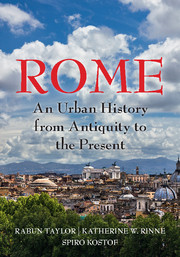Book contents
- Frontmatter
- Dedication
- Epigraph
- Contents
- List of Illustrations
- Acknowledgments
- Map
- INTRODUCTION
- 1 A BEND IN THE RIVER
- 2 A STORYBOOK BEGINNING
- 3 IDEOLOGICAL CROSSFIRE
- 4 BIG MEN ON THE CAMPUS
- 5 RES PUBLICA RESTITUTA
- 6 MEMORIALS IN MOTION: SPECTACLE IN THE CITY
- 7 THE CONCRETE STYLE
- 8 REMAKING ROME'S PUBLIC CORE: I
- 9 REMAKING ROME'S PUBLIC CORE: II
- 10 CRISIS AND CONTINUITY
- 11 RUS IN URBE: A GARDEN CITY
- 12 ADMINISTRATION, INFRASTRUCTURE, AND DISPOSAL OF THE DEAD
- 13 MAPPING, ZONING, AND SEQUESTRATION
- 14 TETRARCHIC AND CONSTANTINIAN ROME
- 15 TROPHIES AND TITULI: CHRISTIAN INFRASTRUCTURE BEFORE CONSTANTINE
- 16 WALLS MAKE CHRISTIANS: FROM FOURTH TO FIFTH CENTURY
- 17 A TALE OF TWO ROMES
- 18 THE ROME OF GOTHS AND BYZANTINES
- 19 CHRISTIAN FOUNDATIONS
- 20 FROM DOMUS LATERANI TO ROMANUM PALATIUM
- 21 THE LEONINE CITY: ST. PETER'S AND THE BORGO
- 22 VIA PAPALIS, THE CHRISTIAN DECUMANUS
- 23 THE URBAN THEATERS OF IMPERIUM AND SPQR
- 24 HOUSING DAILY LIFE
- 25 CHAOS IN THE FORTIFIED CITY
- 26 THE TIBER RIVER
- 27 HUMANIST ROME, ABSOLUTIST ROME (1420–1527)
- 28 PLANNING COUNTER REFORMATION ROME
- 29 PROCESSIONS AND POPULATIONS
- 30 MAGNIFICENT PALACES AND RHETORICAL CHURCHES
- 31 NEOCLASSICAL ROME
- 32 PICTURING ROME
- 33 REVOLUTION AND RISORGIMENTO
- 34 ITALIAN NATIONALISM AND ROMANITÀ
- 35 A CITY TURNED INSIDE OUT
- Glossary of Persons, Places, and Terms
- Works Cited
- Index
8 - REMAKING ROME'S PUBLIC CORE: I
Published online by Cambridge University Press: 05 July 2016
- Frontmatter
- Dedication
- Epigraph
- Contents
- List of Illustrations
- Acknowledgments
- Map
- INTRODUCTION
- 1 A BEND IN THE RIVER
- 2 A STORYBOOK BEGINNING
- 3 IDEOLOGICAL CROSSFIRE
- 4 BIG MEN ON THE CAMPUS
- 5 RES PUBLICA RESTITUTA
- 6 MEMORIALS IN MOTION: SPECTACLE IN THE CITY
- 7 THE CONCRETE STYLE
- 8 REMAKING ROME'S PUBLIC CORE: I
- 9 REMAKING ROME'S PUBLIC CORE: II
- 10 CRISIS AND CONTINUITY
- 11 RUS IN URBE: A GARDEN CITY
- 12 ADMINISTRATION, INFRASTRUCTURE, AND DISPOSAL OF THE DEAD
- 13 MAPPING, ZONING, AND SEQUESTRATION
- 14 TETRARCHIC AND CONSTANTINIAN ROME
- 15 TROPHIES AND TITULI: CHRISTIAN INFRASTRUCTURE BEFORE CONSTANTINE
- 16 WALLS MAKE CHRISTIANS: FROM FOURTH TO FIFTH CENTURY
- 17 A TALE OF TWO ROMES
- 18 THE ROME OF GOTHS AND BYZANTINES
- 19 CHRISTIAN FOUNDATIONS
- 20 FROM DOMUS LATERANI TO ROMANUM PALATIUM
- 21 THE LEONINE CITY: ST. PETER'S AND THE BORGO
- 22 VIA PAPALIS, THE CHRISTIAN DECUMANUS
- 23 THE URBAN THEATERS OF IMPERIUM AND SPQR
- 24 HOUSING DAILY LIFE
- 25 CHAOS IN THE FORTIFIED CITY
- 26 THE TIBER RIVER
- 27 HUMANIST ROME, ABSOLUTIST ROME (1420–1527)
- 28 PLANNING COUNTER REFORMATION ROME
- 29 PROCESSIONS AND POPULATIONS
- 30 MAGNIFICENT PALACES AND RHETORICAL CHURCHES
- 31 NEOCLASSICAL ROME
- 32 PICTURING ROME
- 33 REVOLUTION AND RISORGIMENTO
- 34 ITALIAN NATIONALISM AND ROMANITÀ
- 35 A CITY TURNED INSIDE OUT
- Glossary of Persons, Places, and Terms
- Works Cited
- Index
Summary
THE NAME “COLOSSEUM” IS OF MEDIEVAL ORIGIN, REFERRING SIMPLY TO the amphitheater by the Colossus – a towering gilded bronze statue, more than 30 meters high, of Sol, the sun god. Originally erected farther west, in an entrance court of the Domus Aurea, it began as a nude portrait statue of Nero. This identity could not be allowed to stand, and probably under Vespasian (69–79) it acquired the more generic features of Sol. Yet Sol was an exotic import with little devotional value in Italy. Evidently the statue was saved because it was an object of awe – a monument worthy of the caput mundi, the head of the world, supplanting the long-collapsed colossal sun god of Rhodes among the world's wonders. Hadrian later had it moved at great expense to its place near the amphitheater.
Founder of the new Flavian dynasty, Vespasian confronted a delicate ideological task. It was not enough to put a new face on a statue; the city itself needed somehow to shed its Neronian identity without needlessly destroying Nero's genuine achievements. The amphitheater was a hedge of sorts. Its introduction constituted a symbolic erasure and emendation, but it was also a building of high public value replacing an inessential amenity. Another monument nearby, the baths later completed by his son, Titus, who would succeed Vespasian as emperor (79–81), also contributed to this campaign. The baths occupied a decommissioned sector of the Domus Aurea, yet they were consciously modeled on Nero's splendid prototype in the Campus Martius. Their most original feature was a gargantuan covered stairway thrust out from the slope almost up against the Colosseum (Fig. 46). Broad and hulking, it was a veritable cartoon of public accessibility, like the monument to Vittorio Emanuele II on the Capitoline Hill today. Whether or not inspired by some precedent, it was clearly intended as an ostentatious declaration: this place benefits and belongs to everyone.
Vespasian's priority was to break with Nero's cult of personality while emphasizing the continuity of traditional institutions in Rome. In the heart of the city, he achieved this with projects at opposite extremes of the Forum valley. The most urgent task lay at the northwest end, on the summit of the Capitoline Hill.
- Type
- Chapter
- Information
- RomeAn Urban History from Antiquity to the Present, pp. 72 - 81Publisher: Cambridge University PressPrint publication year: 2016



